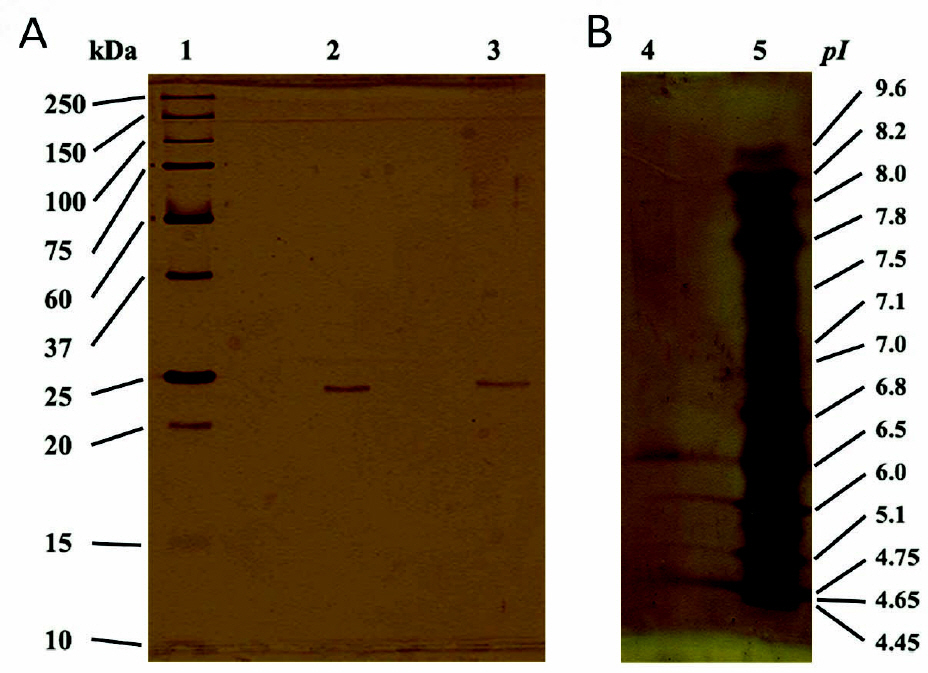Korean J Physiol Pharmacol.
2011 Aug;15(4):241-244. 10.4196/kjpp.2011.15.4.241.
Molecular Characterization and Mitogenic Activity of a Lectin from Purse Crab Philyra Pisum
- Affiliations
-
- 1Physical Pharmacy Laboratory, College of Pharmacy, Chung-Ang University, Seoul 156-756, Korea. hahyung@cau.ac.kr
- KMID: 1448928
- DOI: http://doi.org/10.4196/kjpp.2011.15.4.241
Abstract
- A lectin from the hemolymph of purse crab, Philyra pisum, was found to have anti-proliferative activity on human lung cancer cells by our laboratory. In this study, P. pisum lectin (PPL) was molecularly characterized including molecular mass, amino acid sequences, amino acid composition, and the effects of metal ions, temperature, and pH on the activity. We found that PPL showed mitogenic activity on human lymphocytes and BALB/c mouse splenocytes. The mitogenic activity (maximum stimulation index, SI=9.57+/-0.59) of PPL on human lymphocytes was higher than that of a standard well-known plant mitogen, concanavalin A (maximum SI=8.80+/-0.59). The mitogenic activity mediated by PPL is required for optimum dosing, and higher or lower concentrations caused decreases in mitogenic response. PPL also induced mitogenic activity on mouse splenocytes, however, the maximum SI (1.77+/-0.09) on mouse splenocytes of PPL was lower than that (2.14+/-0.15) of concanavalin A. In conclusion, PPL is a metal ion-dependent monomer lectin with mitogenic activity, and could be used as a lymphocyte or splenocyte stimulator.
MeSH Terms
Figure
Reference
-
References
1. Lis H, Sharon N. Lectins as molecules and as tools. Annu Rev Biochem. 1986; 55:35–67.
Article2. Bies C, Lehr CM, Woodley JF. Lectin-mediated drug targeting: history and applications. Adv Drug Deliv Rev. 2004; 56:425–435.
Article3. Sharon N, Lis H. Lectins–proteins with a sweet tooth: functions in cell recognition. Essays Biochem. 1995; 30:59–75.4. Singh Bains J, Singh J, Kamboj SS, Nijjar KK, Agrewala JN, Kumar V, Kumar A, Saxena AK. Mitogenic and anti-proliferative activity of a lectin from the tubers of Voodoo lily (Sauromatum venosum). Biochim Biophys Acta. 2005; 1723:163–174.5. Medzhitov R, Janeway CA Jr. Innate immunity: the virtues of a nonclonal system of recognition. Cell. 1997; 91:295–298.
Article6. Kilpatrick DC. Use of lectins as mitogens for lymphocytes. Rhodes JM, Milton JD, editors. Lectin methods and protocols. Totowa NJ: Humana Press;1998. p. 385–392.
Article7. Jung EC, Kim KD, Bae CH, Kim JC, Kim DK, Kim HH. A mushroom lectin from ascomycete Cordyceps militaris. Biochim Biophys Acta. 2007; 1770:833–838.
Article8. Ho JC, Sze SC, Shen WZ, Liu WK. Mitogenic activity of edible mushroom lectins. Biochim Biophys Acta. 2004; 1671:9–17.
Article9. Ghosh S, Majumder M, Majumder S, Ganguly NK, Chatterjee BP. Saracin: a lectin from Saraca indica seed integument induces apoptosis in human T-lymphocytes. Arch Biochem Biophys. 1999; 371:163–168.
Article10. Kim HH, Jun JI, Kim BS, Cho DH, Min TH, Kim YJ, Ryu CS. Lectin protein prepared from Korean marine crab philyra pisum, process for preparing the same and the use thereof. United States Patent. 2004. 0185428.11. Bradford MM. A rapid and sensitive method for the quantitation of microgram quantities of protein utilizing the principle of protein-dye binding. Anal Biochem. 1976; 72:248–254.
Article12. Kim BS, Oh KT, Cho DH, Kim YJ, Koo WM, Kong KH, Kim HH. A sialic acid-binding lectin from the legume Maackia fauriei: comparison with lectins from M. amurensis. Plant Science. 2004; 167:1315–1321.
Article13. Laemmli UK. Cleavage of structural proteins during the assembly of the head of bacteriophage T4. Nature. 1970; 227:680–685.
Article14. Olafsen JA. Lectins: models of natural and induced molecules in invertebrates, Advances in Comparative and Environmental Physiology. Berlin, Heidelberg: Springer Verlag. 1996. 49–76.15. Iwanaga S. The molecular basis of innate immunity in the horseshoe crab. Curr Opin Immunol. 2002; 14:87–95.
Article16. Fragkiadakis GA, Stratakis EK. The lectin from the crustacean Liocarcinus depurator recognizes O-acetylsialic acids. Comp Biochem Physiol B Biochem Mol Biol. 1997; 117:545–552.
Article17. Ahmed SA, Gogal RM Jr, Walsh JE. A new rapid and simple non-radioactive assay to monitor and determine the proliferation of lymphocytes: an alternative to [3H]thymidine incorporation assay. J Immunol Methods. 1994; 170:211–224.18. Huong PL, Kolk AH, Eggelte TA, Verstijnen CP, Gilis H, Hendriks JT. Measurement of antigen specific lymphocyte proliferation using 5-bromo-deoxyuridine incorporation. An easy and low cost alternative to radioactive thymidine incorporation. J Immunol Methods. 1991; 140:243–248.
Article19. Niks M, Otto M, Busová B, Stefanovic J. Quantification of proliferative and suppressive responses of human T lymphocytes following ConA stimulation. J Immunol Methods. 1990; 126:263–271.
- Full Text Links
- Actions
-
Cited
- CITED
-
- Close
- Share
- Similar articles
-
- Binding Specificity of Philyra pisum Lectin to Pathogen-Associated Molecular Patterns, and Its Secondary Structure
- Comparison between Immunostimulatory Activity and Molecular Structure of Different Polysaccharides
- Advances in Understanding the Molecular Biology of Brain Tumors
- Characterization of the Multinucleated Giant Cell Glycoconjugates in the Tubercle of Human Pulmonary Tuberculosis
- Optimizing Treatment for Carbapenem-Resistant Acinetobacter baumannii Complex Infections: A Review of Current Evidence


